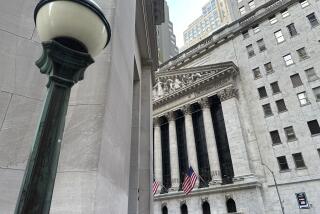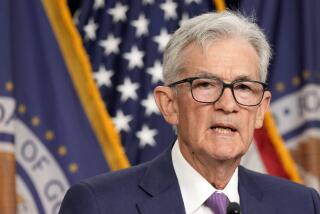Spring May See Interest Rates Sprout After Winter’s Slide
- Share via
The four-month-long slide in U.S. interest rates may be coming to at least a temporary end, as the economy shows signs of picking up steam after a first-quarter slowdown.
If rates indeed are turning up again--however modestly by last year’s standards--the shift will interrupt not only the bond market’s 1995 rally, but also could halt the stock market’s record-breaking advance, analysts warn.
Many bond market pros have been arguing for weeks that some kind of rebound in interest rates was overdue, after a long decline that has pulled bond yields down as much as 1.25 percentage points since year’s end.
Now, a number of elements could combine to create the needed catalyst for a spring turn in rates, some analysts say.
“I do think we’re in a period of change, and it’s not one that bodes well for the bond market,” says Tom Sowanick, head of taxable bonds at Merrill Lynch & Co. in New York.
Here’s what worries Wall Street:
* Despite Friday’s weak first-quarter gross domestic product report--which pegged the quarter’s real growth at 2.8%, slowest since mid-1993--some of last week’s reports on more recent economic activity pointed to a revival.
For example, durable goods orders and sales of existing homes both were up in March. And a Chicago-area survey of manufacturing activity showed a surprising jump in April.
By Friday, nerves in the bond market were clearly jangled, as traders looked ahead to this week’s heavy calendar of economic reports. Fears that a stronger economy could put upward pressure on rates sent the yield on one-year Treasury bills up to 6.30% by Friday from 6.13% at the start of the week.
* Two key groups of potential bond buyers appear increasingly unlikely to step up to the plate. One is foreign central banks, whose efforts to halt the dollar’s plunge resulted in their purchases of large sums of short-term Treasury securities through April.
Now, with the U.S. currency apparently stabilized, central banks “won’t have to mop up unwanted dollars,” says Sung Won Sohn, economist at Norwest Corp. in Minneapolis. An unfortunate side effect is that short-term Treasury yields, artificially depressed as central banks gobbled U.S. securities, may automatically rebound in coming weeks.
Meanwhile, individual investors have shown no interest in pumping large new sums into bond mutual funds, and in fact pulled a net $3.7 billion out of the funds in March--despite the market’s continuing rally. And when the Treasury sold new two- and five-year notes last week, small investors’ purchases were the lowest in 13 months.
* As demand for bonds threatens to wane, supply is increasing. In its once-a-quarter “refunding,” the Treasury will sell about $30 billion in three- and 10-year notes next week. That sale comes hard on the heels of last week’s auction of $29 billion in two- and five-year notes.
There’s never any question that the government will sell its paper; the price is the only issue. If the economy shows more signs of perking up, while a bigger inventory of new bonds faces a smaller pool of buyers, interest rates may simply have to back up a bit, analysts say.
But back up how much? For starters, yields on three- and six-month Treasury bills, now at 5.88% and 6.08% respectively, could easily move up a quarter-point each, some economists say. That would just restore those yields to more normal levels relative to the 6% “federal funds” rate (the overnight bank-lending rate) that the Federal Reserve Board currently maintains as its benchmark short-term interest rate.
Then, if economic data in coming weeks is indeed stronger than expected, yields on intermediate-term bonds also could move up a quarter-point or more, some pros say, as the market reconsiders whether the Fed may again have to raise short-term rates to cool the economy.
Cathy A. Jameson, director of fixed-income investments at Wood Struthers & Winthrop in New York, says her main worry isn’t that long-term yields (say, on the 30-year Treasury bond) might surge this spring, but that a market “correction” will hit bonds in the one- to three-year maturity range hardest.
Because yields on those securities have fallen fastest this year, “You have to question the validity of purchasing short-term maturities now,” she says--especially if you’re concerned that the market is ripe for a setback.
For example, the one-year Treasury bill yield started the year at 7.17%, and so is off 0.87 point at the current yield of 6.30%. In contrast, the 30-year T-bond yield, at 7.34% now, is down just 0.54 point from 7.88% at year’s end.
Yet even some of the bond market’s biggest bears concede that any rise in interest rates this spring or summer should be viewed with perspective. At the very worst, short-term yields might rise a full percentage point if the economy proves so strong that the Fed must tighten credit again, some pros say.
A rate change from 6% to 7% would be far less damaging to bondholders’ principal than what occurred in 1994, when short-term rates doubled from 3% to 6%.
Many analysts doubt that rates will back up even a half-percentage point this spring. “I’d be shocked if we had a half-point reversal,” says David Resler, economist at Nomura Securities in New York. While bonds may be primed for profit taking, “I don’t think it can be sustained.” he says. Any rise in rates “becomes self-defeating,” Resler says, by putting a new squeeze on the economy.
The big surprise could be that yields on longer-term issues (10- to 30-year bonds) don’t rise much even if shorter-term rates jump. Long-term bond yields take their cue mainly from inflation trends, and so far U.S. inflation still appears under control--in the 3% to 4% annualized range for consumer prices.
“The inflation picture seems almost pastoral,” says John R. Williams, economist at Bankers Trust Co. in New York.
Tad Rivelle, bond fund manager at Hotchkis & Wiley in Los Angeles, isn’t quite so sanguine about near-term inflation; price increases almost always accelerate late in an economic expansion, he says.
He also notes that the argument about long-term yields staying flat in an environment of rising short-term yields certainly proved erroneous in 1994.
Even so, Rivelle believes that annualized inflation will peak below 5% in this economic cycle, then decline again. For that reason, he says, investors should be buying bonds aggressively if yields jump this spring or summer.
“If you can get long-term bonds at yields of 7.5% to 7.75%, that’s a great investment,” Rivelle says.
More to Read
Inside the business of entertainment
The Wide Shot brings you news, analysis and insights on everything from streaming wars to production — and what it all means for the future.
You may occasionally receive promotional content from the Los Angeles Times.










